
Knowing you learning style can really benefit you in many different ways. It can help you study for a test, memorize something, stay up to date professionally in the most effective ways so that you will be a pro at whatever it is that you are learning. Knowing your own learning style can increase self confidence, maximize your learning, tell you your strengths and weaknesses, and can improve your collaboration with others.
Many students and teachers can benefit from knowing their learning styles. It can become easier to understand certain subjects if you learn it in one specific way that works for you. When you are a teacher and you are teaching your class something, maybe your students are more engaged when you teach through experiments, or maybe they are more engaged through watching presentations. Pay attention to these things and it just might help you and your students in many ways.
No matter what age you are discovering your learning style can help you in so many great ways! So what is your learning style?
The Different Learning Styles
Next time you are in class or find yourself learning something new, take note on the way you are being taught, and how it works for you. You can be more efficient when learning if you know what learning style makes the most sense to you. It is important not to get attached to the specific category of learning that you think you are part of. People have many different learning styles, that range depending on what subjects they are learning.
There are many different theories to how many learning styles there are, but today I’m going to talk about the VARK theory and the Memletic learning styles.
Memletics
There are many different theories to the different types of ‘main’ learning styles and how many there are, but first I’m going to talk about the memletic learning styles. Memletic is an accelerated learning program created by Sean Whiteley. The program promises to help people improve their memory and learn quicker.
Within the memletic learning program there are 7 different styles of learning that interwind with each other. You will probably have multiple learning styles, some being more dominant than others. Or maybe some learning styles for you are more dominant in certain situations. It all completely depends on the person, as each individual has a different mix of learning styles.
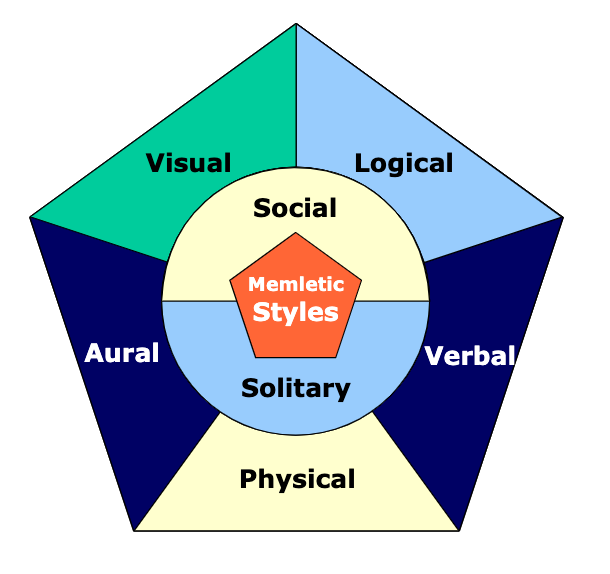
The 7 learning styles are, Visual, Logical, Verbal, Physical, Aural, Social and Solitary. Don’t become set on only one learning styles, or the specific names, because understanding your learning styles is not about the titles.
(image credit: Sean Whiteley, memletics accelerated learning program manual)
To figure out which learning styles suit you best, do the test on page 151 that Sean Whiteley put together as part of his program to help people discover how to improve memory and learn faster. The test will ask you 70 questions in which you need to answer with a zero, one or two. Zero means the description sounds nothing like you, two means the description sounds exactly like you, and one is in between. On page 156 you can write wether you answered with a zero, one or two in the shaded box for each question number.
VARK
VARK was created in 1992, when Colleen Mills and Neil D. Fleming suggested four categories that reflected the learning of students and teachers. The other most popular system of learning styles is VARK. In total there are 3 main learning styles within VARK, being Visual, Auditorial, and Kinesthetic. VARK’s main learning styles are also some of the learning styles in the memletics learning programs.
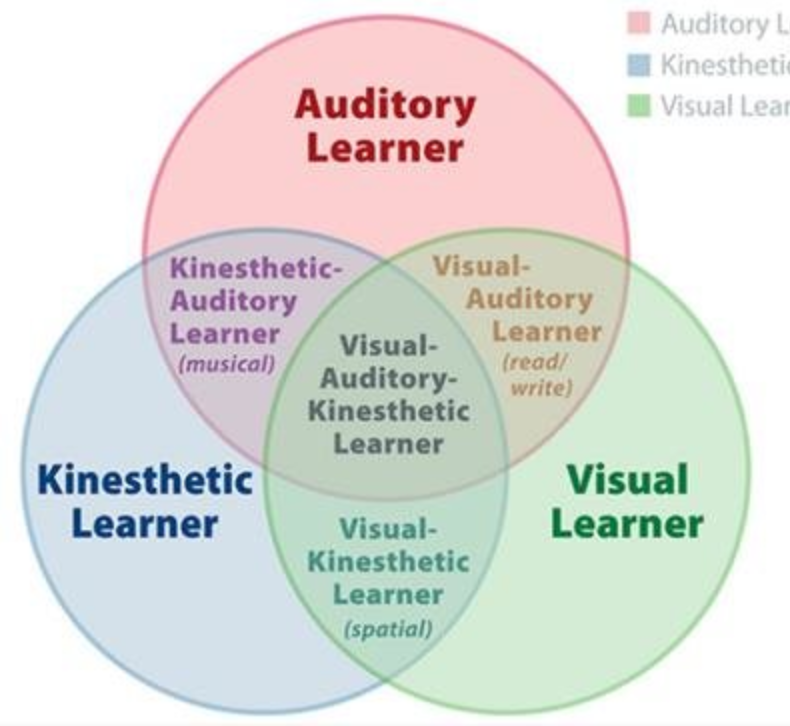
But there are also bimodal and trimodal mixes between these 3 styles so if you think your learning style is Visual and Auditorial, then you are a Visual-Auditorial learner (reading and writing).
(image credit: J.Dragonfly, Flickr; Becton, 2019)
Then there is an Auditorial-Kinesthetic learner (musical), and the last bimodal is a Visual-Kinesthetic learner (spatial). But you can also be a trimodal learner, which means you learn well through all three methods.
So let’s get into the specific details of the different types of learning styles.
Visual

Do you like to take a lot of notes, and highlight them using all different types of colours? Or maybe you like to draw out diagrams to remember things? Well, then one of your learning styles is probably visual. Visual learning is one of the main learning categories for both VARK and memletics.
Visual learners prefer using pictures, images, colours, graphics, maps, diagrams, and drawings to learn and remember things. Normally this will not include real life images but instead designs and graphics. Visual learners tend to see words as images in their minds and they have a more spatial understanding. Having a good spatial understanding allows you to have a good sense of direction.
Benefits of Being a Visual Learner
- Students who learn visually can develop higher-order thinking skills.
- Visual learners are often, are creatively, technologically, or mechanically talented.
- They often arrive at correct solutions intuitively.
- Visuals are processed 60,000 times faster in the brain than text, which can speed up the learning process for visual learners, when they are being taught through visuals.
- Visual learners can see the big picture which can help them keep their final destination in sight.
- According to Dr. Lynell Burmark visuals, like images and drawings sticks in our long term memory. Pairing concepts with meaningful images makes it easier to store information in our long term memories. So from being a visual learner you may have a better long term memory when you learn something visually.
Learning Tips
- Watching the person speaking can often help visual learners to understand and process information especially if there are visuals during the presentation. Even without visuals paying attention to the speaker can help you just from watching hand gestures and body language.
- Use colours, highlighters and a colour coding system for notes. This way you will remember things just from the colour they were in. It can be extra helpful if you have special colours for certain subjects, that way you can remember what category the note is in.
- Use graphs, mind maps, charts and diagrams to help memorize and learn. Even re-writing and drawing things might help you.
- Try writing out keywords to
- Create an image in your mind or visualize words to remember the topic you are learning.
Auditory/Aural
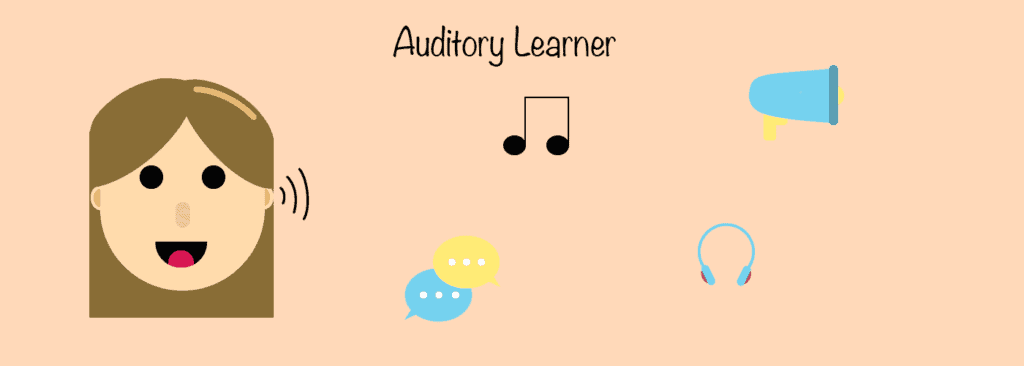
Do you often talk to yourself out loud when you are studying, or trying to understand a subject? Or have you ever learned a subject from memorizing a silly song about it on YouTube? You are most likely an aural learner. Aural learners prefer using sound and music to learn. They tend to learn best through listening and speaking.
They typically can play musical instruments, sing, or have a good sense of rhythm and pitch. Aural learners often find themselves humming a tune in their heads or out loud, that just popped into their heads randomly. But aural learners might be aural in sounds and talking instead of music. They learn well from lectures, discussions, web chat, using mobile devices, and so pretty much every type of talking out loud, to themselves or others.
Benefits
- Aural learners pay attention to details and follow step by step directions very well
- Aural learners are normally pretty organized
- They can learn and memorize math facts quickly
- They are good at talking out loud and in front of the class, making them good at explaining things, good at presentations, and telling stories
- It is unlikely that you will ever be taught something without sound, except for reading materials, so aural learners have an advantage in classes
- Aural learners can memorize songs and tunes very quickly, and they do very well listening to audio books
Learning Tips
- Focus on using aural content in your association and visualization.
- Try to avoid loud or noisy areas where there is no one talking when you are trying to study so that you will have less distractions.
- Reading your notes or content out loud will probably help you remember them better. Try to make the reading dramatic and interesting to listen to which will give you a higher chance that the information stick in your brain.
- If you are learning something like grammar in French class try to find a song on YouTube about that grammar concept and memorize it if you can. That way you will remember the topic when you sing the song in your head.
- Try listening to an audio book instead of reading one, the information you are taking in will probably process faster than if you are simply reading words.
Kinesthetic/Physical
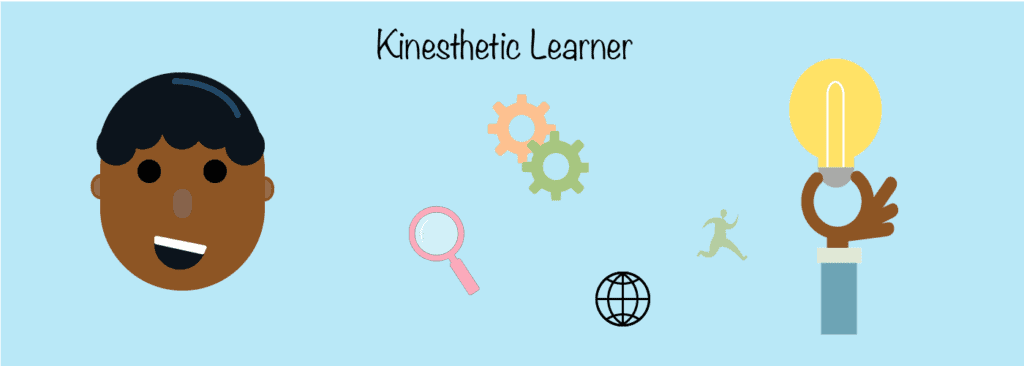
Are you the type of person who needs to actually experience something to understand it? Do you always prefer to do an actual experiment than sit still and read from a textbook? One of your learning styles is probably kinesthetic.
Kinesthetic learning includes learning from hands on experiments, personal experiences, real life examples, and they usually want to get their hands “dirty” and enjoy doing physical activities. If you are a kinesthetic learner you probably do a lot of physical activities, or hands on activities like sewing, gardening, woodworking or cooking. Most people enjoy doing experiments in class, so everyone is a kinesthetic learner in some ways.
Do you feel like you Kinesthetic learning means that you prefer to learn through experience and practice. They learn through the motion of doing things. Kinesthetic learners would prefer to learn from doing an activity or experiment rather than from listening to a lecture or reading from a text book. Kinesthetic learning often includes doing experiments and hands on learning activities.
Benefits
- Kinesthetic learners normally have a good hand-eye coordination.
- They are usually good at physical sports and activities that involve lots of movement.
- Kinesthetic learners learn how to be independent adults because they are learning to do things by themselves through real life activities, so they are experiencing things as if they were in real life, and students get to understand what to do in the certain situations.
- They might have increased retention because of the physical and hands on activities they do.
- If student’s cognitive skills are still being developed kinesthetic learning will help the development by doing hands on activities.
Learning Tips
- If you are studying for an exam, try taking teaching the concepts to whoever is around. Maybe to your parents or siblings, because teaching a concept to others is a great way for kinesthetic learners to ensure that they understand it.
- When studying or doing homework don’t try to do one hour all at once because it can be hard to sit still, it is much easier for kinesthetic learners to study while taking breaks. If you choose to take a break go outside or do a short physical activity.
- Making flashcards is a great way to remember concepts and to quickly test yourself on subjects, and it involves movement.
- Trying to stay active while studying might help you remember things, so maybe try walking around the house or go for an actual walk and quiz yourself, while you are moving.
- Learn by doing hands on learning, experiments, physical activities, and through real life experiences.
Reading and Writing (Verbal)
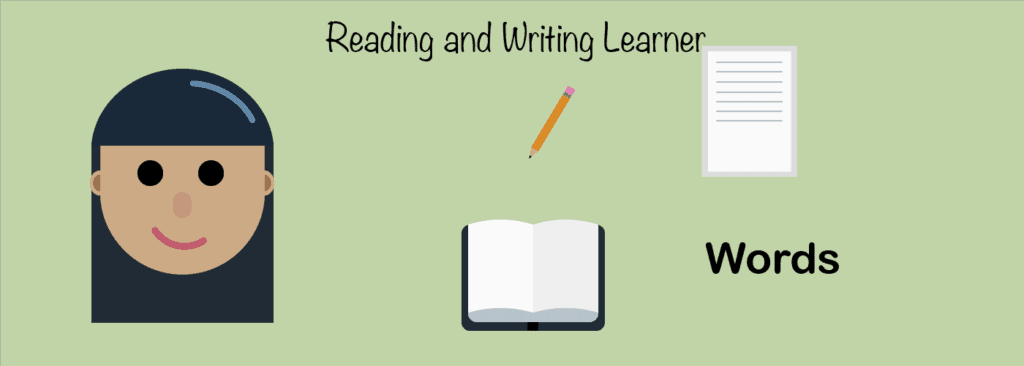
Do you enjoy reading, and getting information from a textbook? Would you rather spend time making a PowerPoint or some sort of list rather than listen to a presentation? These are all signs that you probably enjoy or even prefer the reading/writing (called verbal learning according to memletics) learning styles.
Read/writing learners often use PowerPoint, dictionaries, make lists, have diaries, and Wikipedia. Really anything with words. Like the name suggests, they like to learn from doing things like reading and writing. Often aural information will not stay in their brains, but it is more understandable when they read something from a textbook. Reading/writing learners might enjoy finding rhymes, tongue twisters and they have a wide range of vocabulary. Normally read/writing learners learn through the most traditional ways.
Benefits
- One major benefits of being a reading and writing learner, is that because it is the most traditional style of learning, most classes do a lot of reading/writing, so R&W learners have an advantage.
- Read/writing learners often have improved communication skills.
- They normally know what a lot of different words mean/they have a wide range of vocabulary.
- They can remember list information very well.
- Reading and writing learners normally have strong critical thinking abilities.
Learning Tips
- Taking lots of notes can help you remember concepts especially when you write them in your own words.
- If you are a R&W learner you probably find handouts very useful, so try to keep them safe, and don’t loose them.
- Try making your diagrams, and charts into words, maybe write each chart out in a paragraph.
- Making a list might help you when you are studying for a test because R&W styles are often list people.
- If you have made notes on a certain topic, try re-writing the notes and re-read them, it will help you keep the information in your brain. You will also find re-reading your notes helpful because R&W learners often have a really good comprehension of reading.
Logical
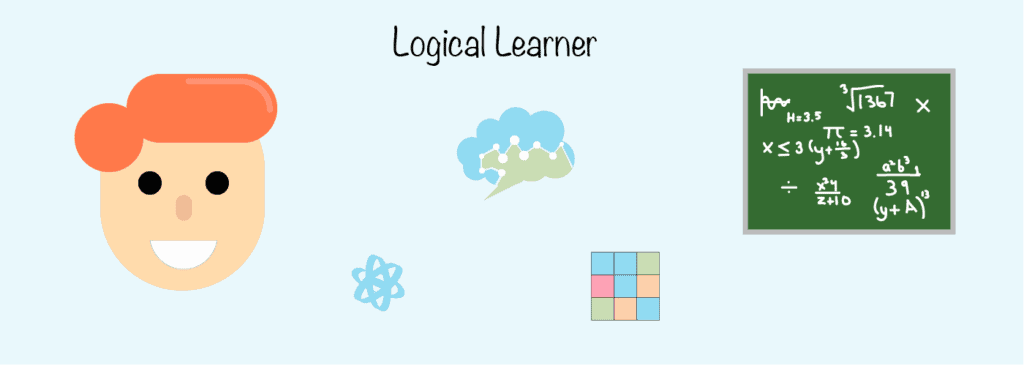
Do you enjoy and excel in math? Do you tend to notice patterns and are a problem solver? Well, then you are probably a logical learner. Logical learners are able to solve complex numbers and calculations. They understand how the calculations work, which not many people are able to do. They tend to remember many math calculations within algebra, and trigonometry. Logical learners can sometimes even do complex calculations in their head.
If you are a logical learner you will probably go through calculations in a systematic way. Logical learners normally enjoy activities like math, sciences that involve math, technology, and computer sciences. They enjoy doing anything that has to do with patterns and problem solving.
Benefits
- Logical learners know how to organize information, facts, and data well.
- They tend to have strong visual memory, decoding skills, and of course problem solving skills.
- When they are working on solving a problem, they like to keep working until they are sure they have gotten the correct answer.
- Logical learners normally plan ahead of time and don’t like to procrastinate because they want to get things done.
- They are good at setting goals and reaching their goals.
Learning Tips
- Don’t just learn subjects but try to understand everything about the concept you’re learning and how it works. For example if you are learning a concept in biology, don’t just memorize the names, but understand how everything works within the cell. By doing that you will have an easier time memorizing the topic.
- Learn through systematic thinking to help understand certain connections within a topic, and understand the bigger picture.
- Look for patterns, and relationships between the concepts you are learning.
- Relate the patterns, or connections you see in the concept you are studying with real life things.
- Make graphs, charts, and diagrams to help understand and organize them in a certain pattern that you have found.
Social

Do love working in a group and have really good communication skills? If so you are probably more of a social learner than a solitary learner. Social learners normally have excellent communication skills verbally and written. People often go to social learners for advice because they are good listeners and understand other points of view well.
Social learners prefer learning in a social environment with a group of other students, and they enjoy one on one learning with their teacher. If you are a social learner you probably like to chat with friends after class. Social learners also enjoy doing team sports rather than individual.
Benefits
- Social learners have really good social and communication skills
- They work well with a team, and doing any sort of team sport
- Social learners are normally people people
- People often go to them for advice because they are good listeners and tend to see other peoples’ points of view
- Social learners learn through communicating with others
Learning Tips
- When studying for a test try to do it with a study group. Because you are a social learner, you probably prefer learning with a group of classmates.
- Acting out a scene might help you study. If you are reading about a war that happened in your socials textbook and you are with a group of people get everyone to be an important character and act out the scene.
- Engaging in class discussions is something that helps social learners understand the concept they are learning about
- Ask for feedback when you working on writing a paper or a project. This is normally something that socials learners enjoy doing, and it is normally quite helpful for them.
- Create mind maps and diagrams when you are working with a group. It may help you see different points of view on your topic.
Solitary
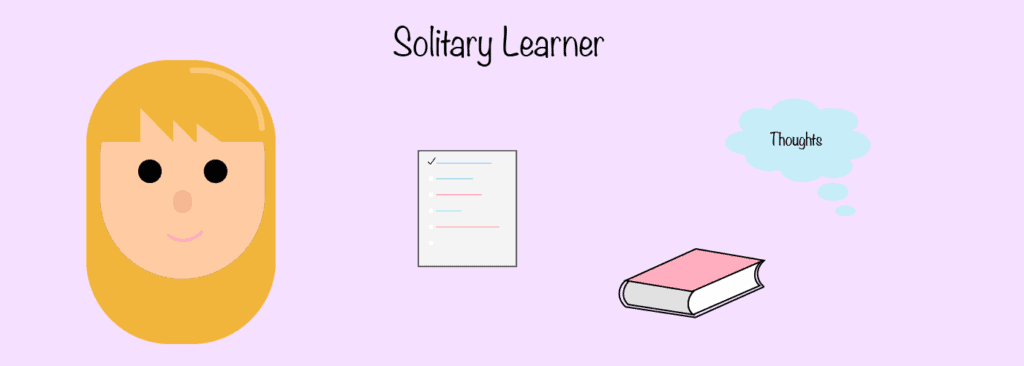
Do you tend to prefer working alone because you can concentrate better? Do you like focusing on your thoughts and feelings on the topic you are learning? These things probably mean you are a solitary learner. Solitary learners are kind of the opposite to social learners. They prefer studying alone where they can process their thoughts on their study concept.
Solitary learners tend to be more private, but are also more independent. They might keep a journal or diary where they write about their thoughts rather than talking about them to other people. Solitary learners normally go over their successes, accomplishments, and challenges. If you are a solitary learning you might prefer to travel in remote places that are not super touristy. You normally prefer, and are more productive when you study or do work alone. You also want to know the direction of life you are taking.
Benefits
- Solitary learners do not depend on others to study or learn a new concept.
- They tend to be very independent mainly when studying, but also when doing other things, like activities.
- They make lots of plans and goals, and always try to reach their goals.
- Solitary learners often are able to memorize things quite easily (if they are studying alone).
- They are very engaged in self-development activities.
Learning Tips
- Like I have said a lot in this section if you are a solitary learner try to do most of your studying alone, because you find it much easier to memorize and understand topics that way.
- Be aware of your inner thoughts when you are studying. Pay attention to how you are feeling about the topic, because this will give you more motivation to learn.
- Set up goals and plans on how you want to spend your time studying or working on a projects. If you visualize and plan out how you want to spend your time, you will be much more productive.
- If you are learning about a boring topic, try to make it interesting for you and maybe even make it relatable.
- Keeping a ‘school’ journal where you write down what learning types work for you and your feelings on certain topics in school will help you understand the topic more.
How Does It Benefit You?
Once you know your learning styles that doesn’t mean you will always have to learn the same way. You learning styles might change over the years, and they might be different for different subjects, so don’t become set on one style. There have been many studies against learning styles, but I think that they can be very helpful if you use them correctly.
It can be hard when you are sitting in a class, having no idea what is going on. Maybe the subject you are being taught is really easy, but for some reason the information will not click in your brain. I’m sure everyone has experienced this at some point in their lives, and it is probably because of the way they are being taught the subject.
Think about it, have you ever been in this situation, but when you repeat the information you just learned out loud it makes more sense. I do this all the time, and that is because I am an auditory learner, so when I hear myself say it, it makes more sense. Or maybe if you write it down or draw it, it makes more sense, that is probably a sign that your brain processes information better when it is visual.
Learning Styles and Homeschooling
One of the great things about homeschooling is that it allows the parent to teach their child in whatever way works best for both of them. This is the reason many parents choose to homeschool their children, because they have the ability to personalize their child’s learning methods based on what the child prefers. In school students do not have the opportunity to have personalized learning because one classroom normally has over 20 students in it. Teachers can not make the learning personalized based on one student’s needs because each student has a different style of learning.
So now that you know the importance of learning styles, how can you use this to benefit your child based on your teaching methods? Well once you have figured out what learning styles best suit your child, try teaching using that learning technique the majority of the time. You probably won’t be able to teach everything to your child in their preferred learning type, but no matter how often you teach like that, the concept will most likely make more sense in your child’s mind. But don’t forget to think about what teaching styles you prefer. And maybe you can make a mix of your favourite teaching styles and your child’s favourite learning styles to make a perfect blend, and benefit both of you.
